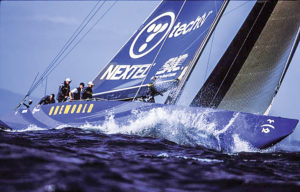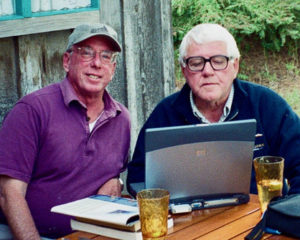This article was originally published in the December 2021 issue of 48° North. Title image courtesy of The Designers Institute of New Zealand.
The world has lost an important yacht designer with the recent passing of New Zealander, Laurie Davidson, on September 4, 2021 at age 94. Davidson had many important ties to the Pacific Northwest, including living for a number of years in Seattle and Bellingham; and he happened to be a longtime sailing friend of mine.
At age 21, Laurie was racing the 18-foot wooden M Class in Auckland. He designed and built a much faster boat and won most all the races until it was banned the following season. His design career was launched!
During the 1950s and 60s Laurie worked as an accountant and pursued his passion for yacht design on the side. The boats he drew were generally racer-cruisers, often built of the excellent local Kauri wood.
Laurie always enjoyed working with numbers, especially the various yacht racing rule formulas. His first personal design requirements stipulated that his boats must be fast and also good looking.

In the early 1970s, the new International Offshore Rule (IOR) was adopted worldwide as the rating rule for racing keelboats. Laurie studied and became familiar with the rule and designed many very successful boats. His favorite client, John MacLaurin of Los Angeles, had him design a series of IOR boats, all named Pendragon. The first was for the 3/4 Ton Cup race in Victoria, Canada in 1978 — which McLaurin’s Davidson-design won easily. A year later, the same 3/4 Ton Pendragon won the One Ton Cup with only slight adjustments for the One Ton rule such as increasing the sail area; this was a unique accomplishment. Laurie’s final Pendragon was 69 feet long and launched in 2009. He designed many other winning IOR boats in this era.
Since most of Laurie’s clients were now in the U.S., he moved to Bellingham, Washington, in the mid 70s; and this is when we became friends. At that time, I was racing a C&C 34, and later an Etchells.
In 1987 Laurie joined the first New Zealand challenge for the America’s Cup in Fremantle, as Australia held the Cup. He partnered with fellow New Zealand designers Bruce Farr and Ron Holland to produce the first fiberglass 12 Meter, Kiwi Magic (previous 12 Meters were built of aluminum). The boat finished second of the thirteen challengers to Dennis Conner sailing Stars and Stripes, which defeated Australia and brought the Cup back to the U.S. in San Diego. This was the last 12 Meter America’s Cup race, and the International America’s Cup Class rule was adopted for the next 20 years until multihulls were selected.
In 1993, Laurie joined Team New Zealand for the 1995 America’s Cup in San Diego with fellow designer Doug Peterson. Their Black Magic NZL 32 trounced Dennis Conner’s Young America 5-0; taking the America’s Cup to Auckland, New Zealand, where a huge enthusiastic crowd welcomed the team home.
For the defense of the Cup in 2000, Laurie became the chief designer at Team New Zealand and moved back to Auckland. He improved on the NZL 32 hull design which most of the challengers were using as their new design. Late in the design process, Laurie developed what became known as the “Davidson Bow” featuring two distinct turns on the underside that increased the effective sailing length and speed without a penalty under the America’s Cup Rule. Again, a Davidson-designed boat won in five straight races against the Italian challenger Luna Rossa, thus retaining the Cup for New Zealand. The entire country was totally absorbed in the defense and almost all the televisions were tuned to the races when they started at noon each day!
For the 2003 America’s Cup Defense, Laurie was brought aboard as chief designer for Craig McCaw’s One World Challenge — a team based in Seattle and with which many 48° North readers will no doubt be familiar. He moved to Seattle, as the two boats were designed there and built in Sedro Woolley — a very Pacific Northwest endeavor. A number of other Team New Zealand members joined One World racing under the Seattle Yacht Club burgee. Later, when more funding was needed, Paul Allen joined McCaw as a sponsor.
One World sailed well in the Louis Vuitton Challenger Series and tied for second with Oracle-BMW; while the Swiss boat Alinghi won the challenge and raced Team New Zealand, whom they defeated, thereby taking the Cup to Europe for the first time. Laurie then retired from the America’s Cup and continued with the design of fast, good looking boats.

Many Davidson designs can be seen sailing our local waters. Included in his Pacific Northwest design legacy is the locally-produced Davidson Dash 34, which were built between 1981 and 1984 and are still common and competitive on racecourses around the region today. Racers will also recognize Davidson designs with overflowing trophy cases, like Davidson 29, Madame Pele, and the Davidson 40, Teddy Bear, among numerous others.
Laurie completely retired from yacht design at age 90 and gave all his drawings and materials to his long time associate Kevin Dibley of Dibley Marine Yacht Design in Auckland, which continues the tradition of Laurie’s fast and attractive boats.
Laurie also had diverse interests outside of sailing, ranging from powerboats to architecture. Upon moving to Bellingham, he chose a 37-foot planing powerboat to explore the San Juan and Gulf Islands, since he found our summer winds to be too light compared to his experiences in New Zealand. Given his interest in architecture, he owned a number of modern houses, some of which he designed. All of them had a view of the sea, of course.
In addition to our happy times together here in the Pacific Northwest, my wife, Gail, and I were delighted to visit Laurie in New Zealand in 2000, 2003, and 2014 to experience the excitement of the America’s Cup and the perfect sailing waters of an exceptional country.
Congratulations to my friend Laurie for a life very well-lived. His success and legacy in yacht design speaks for itself. And all along the way, he benefited from the love and support of his enthusiastic wife, Kay.
Fair winds and farewell, Laurie.






